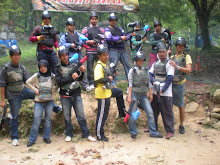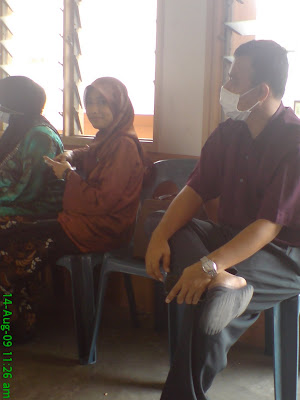
Blog ArchivepROFILE
Categories
|
Labels
|

SK PANDAN PERDANA
BERUSAHA,BERILMU, BERAMAL
APA CERITA?
| FENOMENA H1N1...!!! | 9:52 PM |
|
comments (0)
Filed under:
KEMPEN H1N1
|
|
| NEW FOUND PLANET ORBITS BACKWARD | 9:19 AM |
|
Filed under:
INFO
|
|
Jeanna Bryner and Robert Roy BrittSPACE.com Jeanna Bryner And Robert Roy Brittspace.com – Wed Aug 12, 11:21 am ET
Updated 11:05 a.m. ET
Planets orbit stars in the same direction that the stars rotate. They all do. Except one.
A newfound planet orbits the wrong way, backward compared to the rotation of its host star. Its discoverers think a near-collision may have created the retrograde orbit, as it is called.
The star and its planet, WASP-17, are about 1,000 light-years away. The setup was found by the UK's Wide Area Search for Planets (WASP) project in collaboration with Geneva Observatory. The discovery was announced today but has not yet been published in a journal.
"I would have to say this is one of the strangest planets we know about," said Sara Seager, an astrophysicist at MIT who was not involved in the discovery.
What's going on
A star forms when a cloud of gas and dust collapses. Whatever movement the cloud had becomes intensified as it condenses, determining the rotational direction of the star. How planets form is less certain. They are, however, known to develop out of the leftover, typically disk-shaped mass of gas and dust that swirls around a newborn star, so whatever direction that material is moving, which is the direction of the star's rotation, becomes the direction of the planet's orbit.WASP-17 likely had a close encounter with a larger planet, and the gravitational interaction acted like a slingshot to put WASP-17 on its odd course, the astronomers figure.
"I think it's extremely exciting. It's fascinating that we can study orbits of planets so far away," Seager told SPACE.com. "There's always theory, but there's nothing like an observation to really prove it."
Cosmic collisions are not uncommon. Earth's moon was made when our planet collided with a Mars-sized object, astronomers think. And earlier this week NASA's Spitzer Space Telescope found evidence of two planets colliding around a distant, young star. Some moons in our solar system are on retrograde orbits, perhaps at least in some cases because they were flying through space alone and then captured; that's thought to be the case with Neptune's large moon Triton.The find was made by graduate students David Anderson at Keele University and Amaury Triaud of the Geneva Observatory.
Bloated world
WASP-17 is about half the mass of Jupiter but bloated to twice its size. "This planet is only as dense as expanded polystyrene, 70 times less dense than the planet we're standing on," said professor Coel Hellier of Keele University.
The bloated planet can be explained by a highly elliptical orbit, which brings it close to the star and then far away. Like exaggerated tides on Earth, the tidal effects on WASP-17 heat and stretch the planet, the researchers suggest.
The tides are not a daily affair, however. "Instead it's creating a huge amount of friction on the inside of the planet and generating a lot of energy, which might be making the planet big and puffy," Seager said.
WASP-17 is the 17th extrasolar planet found by the WASP project, which monitors hundreds of thousands of stars, watching for small dips in their light when a planet transits in front of them. NASA's Kepler space observatory is using the same technique to search for Earth-like worlds.
Video - When Worlds Collide
Top 10 Most Intriguing Extrasolar Planets
10 Ways to Destroy Earth
Original Story: Newfound Planet Orbits Backward
| H1N1 !!!!!! | 3:04 AM |
|
Filed under:
H1N1
|
|
PERHATIAN KEPADA SEMUA PELAJAR DAN GURU SKPP..
SALAH SEORANG MURID TAHUN 6G DIDAPATI SUSPEK POSITIF H1N1 HARAP GURU DAN MURID2 MEMANTAU KESIHATAN MASING2...
SEGERA DAPATKAN RAWATAN JIKA MENGALAMI DEMAM DAN TANDA2 H1N1 YANG LAIN HARAP MAKLUM...
| DEBARAN UPSR KIAN TERASA..KEM SAINS DAN MATEMATIK MENUNJUKKAN KESAN POSITIF. | 12:27 AM |
|
Filed under:
UPSR
|
|
KURANG DARI SATU BULAN DARI SEKARANG MAKA AKAN TIBALAH SAAT UNTUK PARA PELAJAR SKPP TAHUN 6 2009 AKAN MENDUDUKI PEPERIKSAAN UPSR..
PELBAGAI PERSIAPAN TELAH DIJALANKAN BAGI MENEMPUHI UPSR, KEM SAINS DAN MATEMATIK YANG TELAH DIJALANKAN DALAM BULAN LEPAS NAMPAKNYA MEBERIKAN KESAN YANG POSITIF TERHADAP PENCAPAIAN MURID...
SEKALUNG TAHNIAH DIUCAPKAN PADA PARA GURU YANG MEMBANTU.. DAN KEPADA MURID YANG TELAH BERJAYA MENINGKATKAN PRESTASI HARAP DAPAT TERUS BERUSAHA.. NAMUN KEPADA MURID YANG MASIH GAGAL, JGN PUTUS ASA TERUSKAN PERJUANGAN ANDA..
SESUNGGUHNYA KEJAYAAN TIDAK DATANG DENGAN MUDAH..KITA HARUS BERUSAHA KEARAH KEJAYAAN...
BERIKUT ADALAH JADUAL RINGKAS UPSR 2009
SELASA 8 SEPTEMBER 2009
BAHASA MELAYU PEMAHAMAN 08.15 PAGI -09.05 PAGI
BAHASA MELAYU PENULISAN 09.45 PAGI -11.00 PAGI
MATHEMATICS PAPER 2 11.45 PAGI - 12.25 TGH
RABU 9 SEPTEMBER 2009
MATHEMATICS PAPER 1 08.15 PAGI -09.15 PAGI
KHAMIS 10 SEPTEMBER 2009
SCIENCE 08.15 PAGI -9.30PAGI
BAHASA INGGERIS K1 10.15 PAGI -11.05 PAGI
BAHASA INGGERIS K2 11.45 PAGI-01.00 PTG
UJIAN APTITUD 02.15PTG - 03.45 PTG
SELAMAT BERJAYA UNTUK SEMUA.......








